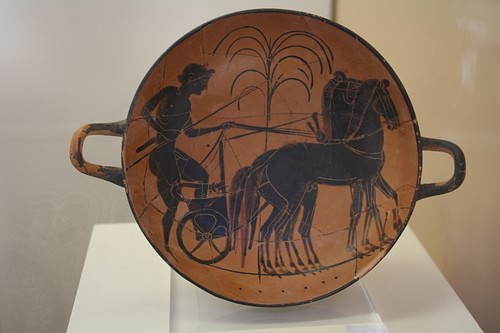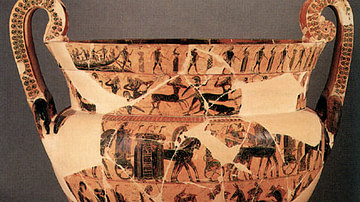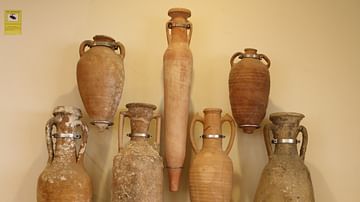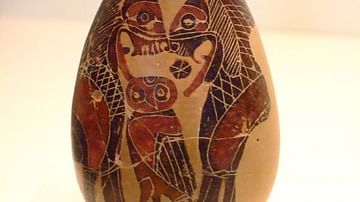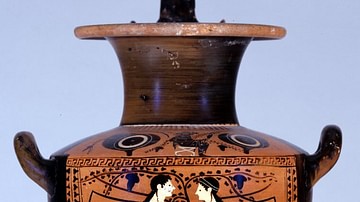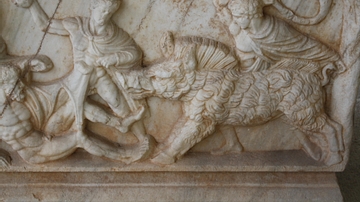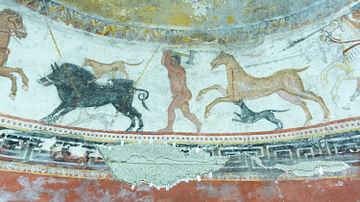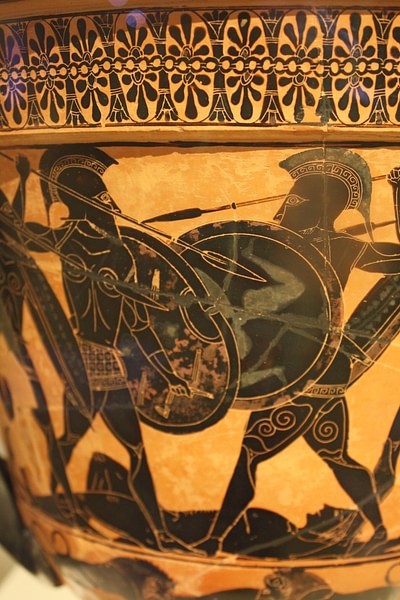
Black Figure Pottery is a type of Greek pottery named after the colour of the scenes painted on vessels. It was first produced in Corinth c. 700 BCE and then adopted by pottery painters in Attica, where it would become the dominant decorative style from 625 BCE. Athenian vases then dominated the Mediterranean pottery market for the next 150 years.
Besides Attica and Corinth, Laconia was a third, albeit minor, producer of the style in the first half of the 6th century BCE. The more than 20,000 surviving black figure vases and vessels of varied form make it possible not only to identify artists and studios, but they also provide the oldest and most diverse representations of Greek mythology, battle scenes, and religious, social, and sporting practices. The pottery vessels are also an important tool in determining the chronology of archaeological sites and the history of ancient Greece in general. The style was eventually replaced by red-figure pottery.
Development
Evolving from the earlier geometric designs on pottery, the black-figure technique depicted animals (more favoured in Corinth) and human silhouette figures (preferred by Athenian painters) in naturalistic detail. Before the firing process, a brilliant black pigment of potash, iron clay, and vinegar (as a fixative) was thickly applied to entire vases or part of the vessel. This black gloss also gave a slight relief effect. Parts of the painted area were then scraped away where not required, leaving a design in silhouette. Additional details such as muscles and hair were added to the figures using a sharp instrument to incise through the black to reveal the clay vessel beneath and by adding touches of red and white paint. Vessel borders and edges were often decorated with floral, lotus, and palmette designs.
Black-Figure Conventions
Certain colour conventions were adopted such as white for female flesh, black for male. Other conventions were an almond shape for women's eyes, circular for males, children are as adults but on a smaller scale, young men are beardless, old men have white hair and sometimes stoop, and older women are fuller-figured. Some gestures also became conventional such as the hand to the head to represent grief. Another striking feature of the style is the lack of literal naturalism. Figures are often depicted with a profile face and frontal body, and runners are in the impossible position of both left (or right) arms and legs moving forward. There was, however, some attempt at achieving perspective, frontal views of horses and chariots being especially popular.
Typical vessels of the style are amphorae, lekythoi (handled bottles), kylixes (stemmed drinking cups), plain cups, pyxides (lidded boxes), and bowls.
Painters and potters were usually, although not always, separate specialists. The first signed vase was by Sophilos and dates to c. 570 BCE. Many other individual painters have been identified with certainty through their signatures (most commonly as '...made this') and many more unsigned artists may be recognised through their particular style.
Perhaps the most celebrated example of the technique is the 6th century Francois Vase, a large volute krater, by Kleitias (c. 570 BCE) which is 66 cm high and covered in 270 human and animal figures depicting an astonishing range of scenes and characters from Greek mythology including, amongst others, the Olympian gods, centaurs, Achilles, and Peleus.
The black-figure style would eventually be replaced by the red-figure (reverse) technique around 530 BCE. The two styles were parallel for some time at the end of the 6th century BCE and there are even 'bilingual' examples of vases with both styles, but the red-figure techniques, with the attempt to more realistically portray the human figure, would eventually become the favoured style of pottery decoration for Greek vases and many other shapes and forms in clay.
